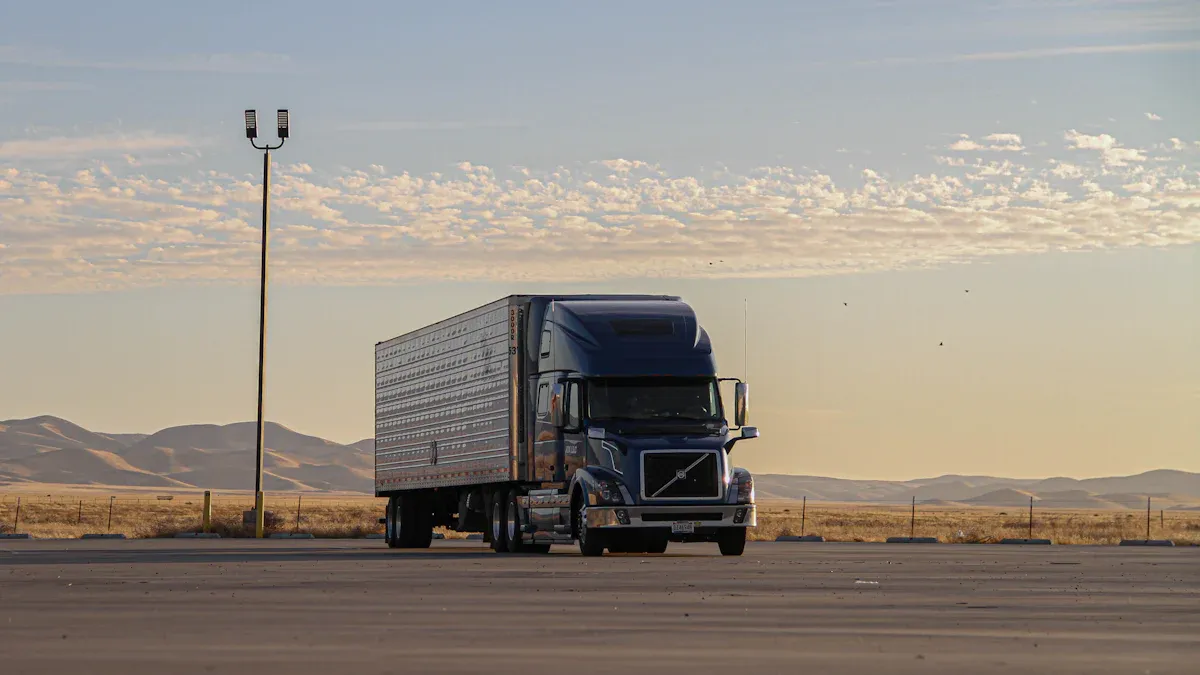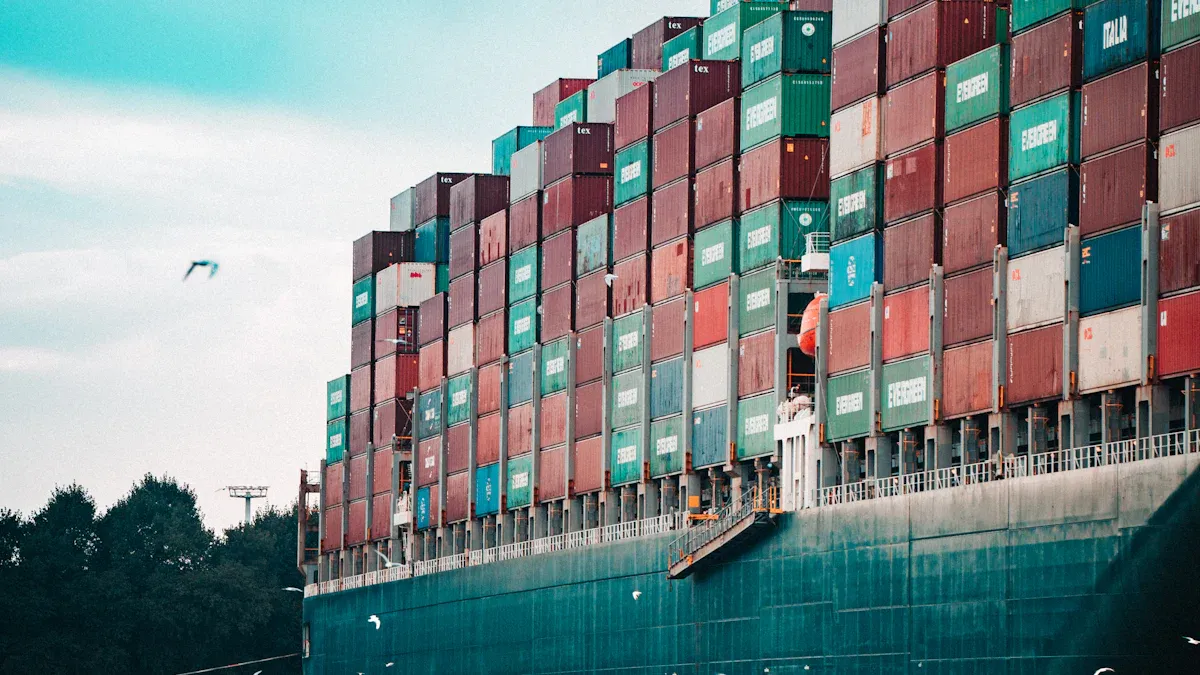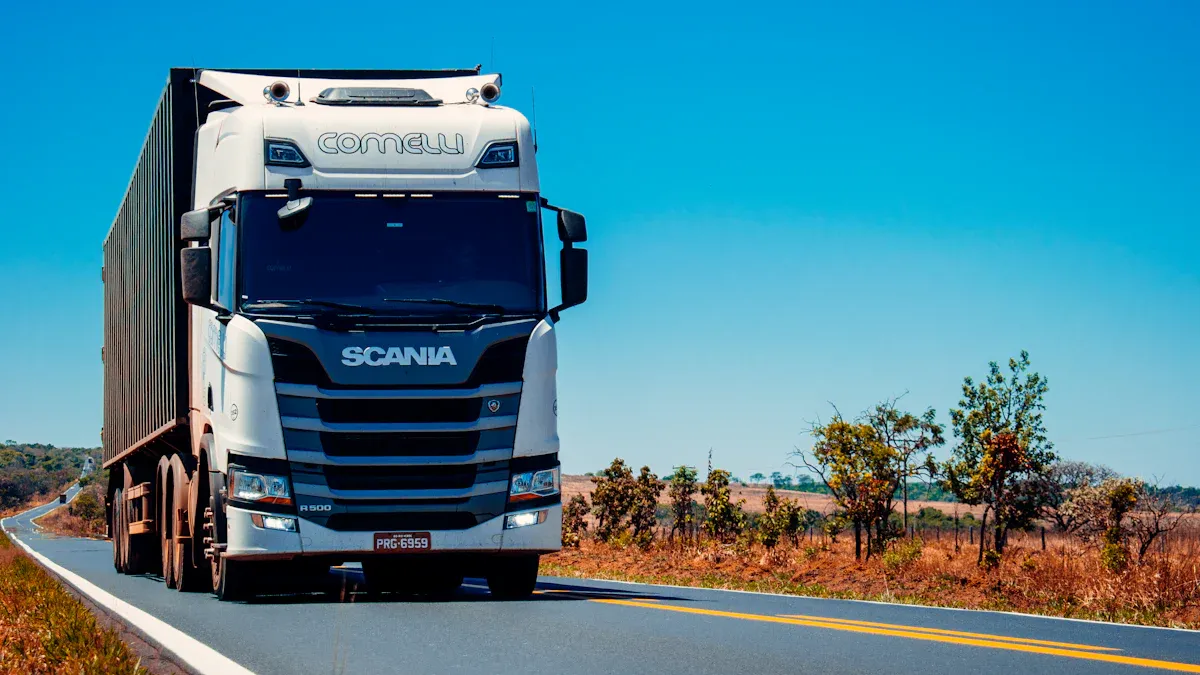LTL vs FTL Shipping Explained for Smarter Logistics Decisions

Less than truckload (LTL) and full truckload (FTL) shipping are two primary freight options businesses use to transport goods. LTL shipping consolidates smaller shipments from multiple shippers into one truck, while FTL dedicates an entire truck to a single shipment. These methods differ in shipment size, cost, transit time, and handling. For instance, over 67% of customers reported shipment delays in the past six months, often due to poor shipping choices. Additionally, companies spent an average of $2.3 million on unexpected LTL fees in 2023. Selecting the right method ensures timely deliveries, reduces costs, and improves customer satisfaction.
What Is Less Than Truckload (LTL) Shipping?

Definition and Overview of LTL
Less than truckload (LTL) shipping refers to a freight transportation method where multiple shippers share space in a single truck. This approach is ideal for businesses that do not require an entire truck for their shipments. LTL shipping typically handles freight weighing between 150 and 15,000 pounds or occupying less than 12 linear feet of trailer space. It offers a cost-effective solution by allowing businesses to pay only for the portion of the truck they use.
LTL shipping optimizes resources by consolidating shipments from various companies, reducing operational costs and environmental impact. As e-commerce continues to grow, the demand for LTL services has surged. The LTL market in the United States is projected to grow from $114 billion in 2025 to $139.6 billion by 2030, reflecting its increasing importance in logistics.
How LTL Shipping Works
The LTL shipping process involves three main stages:
Pickup and Consolidation: Freight is collected from the shipper's location and transported to a terminal. At the terminal, shipments from multiple businesses are consolidated into one truck.
Transportation and Hub Network: The truck moves through a network of terminals, where shipments are sorted and re-routed based on their destinations.
Delivery and Deconsolidation: At the destination terminal, freight is unloaded, sorted, and prepared for final delivery to the consignee.
This structured workflow ensures efficient handling and timely delivery of goods. By sharing truck space, businesses avoid the costs associated with shipping over 12 pallets or using a full truckload.
Common Use Cases for Less-Than-Truckload Shipping
LTL shipping is suitable for businesses with smaller freight shipment needs. Common use cases include:
E-commerce businesses: Companies shipping 12 pallets or less often rely on LTL to manage inventory replenishment and customer orders.
Retailers: Stores frequently use LTL shipping to restock shelves without overloading storage space.
Manufacturers: Businesses transporting raw materials or finished goods in smaller quantities benefit from the cost savings of LTL shipping.
Seasonal shipments: Industries with fluctuating demand use LTL to adjust shipping volumes without committing to a full truckload.
LTL shipping provides flexibility and affordability, making it a preferred choice for businesses across various industries.
What Is Full Truckload (FTL) Shipping?
Definition and Overview of FTL
Full truckload (FTL) shipping refers to a freight transportation method where an entire truck is dedicated to a single shipment. This approach is ideal for businesses with large freight volumes, typically exceeding 10,000 pounds or requiring the full capacity of a trailer. FTL shipping ensures direct transport from the origin to the destination, minimizing handling and reducing the risk of damage.
FTL offers several advantages:
Direct routes enhance distribution efficiency.
Businesses can balance costs with expedited shipping needs.
Full truckload services maximize transport resource utilization.
Evidence Type | Description |
|---|---|
Cost Savings | FTL shipping eliminates multiple freight handling fees, making it more economical for bulk shipments. |
Inventory Management | Scheduling large shipments in advance helps prevent stockouts and reduces last-minute shipping costs. |
Efficiency | Direct shipment routes maximize distribution efficiency for retailers. |
FTL shipping has gained popularity due to its reliability and speed. Statistics show that up to 63% of goods transported by road in Europe utilize the FTL model, reflecting its growing adoption in global logistics.
How FTL Shipping Works
FTL shipping involves filling an entire trailer with goods, ensuring direct transport from the shipper’s location to the consignee. Unlike LTL shipping, which consolidates multiple shipments, FTL minimizes stops and handling.
Feature | FTL (Full Truckload) | LTL (Less Than Truckload) |
|---|---|---|
Shipment Size | Typically for shipments of 10,000 lbs or more | Used for shipments less than 10,000 lbs |
Delivery Speed | Faster delivery due to fewer stops | Slower delivery due to multiple stops |
Handling | Cargo remains in the same truck from origin to destination | Cargo is loaded and unloaded multiple times |
Cost | Higher cost for full truck usage | Cost-effective for smaller shipments |
Security | Increased security as the entire truck is dedicated | Increased risk of damage or theft due to shared space |
FTL shipping’s streamlined process ensures faster delivery times and greater security, making it a preferred choice for businesses transporting high-value or delicate goods.
Common Use Cases for FTL Shipping
FTL shipping is widely used across industries that require large-scale freight transportation. Common use cases include:
Retail and E-commerce: Businesses shipping bulk inventory to distribution centers or stores benefit from FTL’s efficiency.
Food and Beverage: Perishable goods like dairy, fruits, and vegetables rely on FTL for faster delivery and reduced handling risks.
Manufacturing: Companies transporting heavy machinery or raw materials often choose FTL for its capacity and reliability.
Pharmaceuticals: Sensitive products requiring temperature control and minimal handling favor FTL shipping.
Industry | Reliance on FTL Shipping |
|---|---|
Dairy, Fruit, Vegetables, Nuts | |
Lumber and Wood Products | 91.9% |
Agriculture products | 82.7% |
Pharmaceutical products | 65% |
FTL shipping’s ability to provide dedicated cargo space and faster delivery times makes it indispensable for industries with high-volume or time-sensitive freight needs.
Key Differences Between LTL and FTL Shipping

Shipment Size and Volume
The shipment size is one of the most significant factors when choosing between less-than-truckload and full truckload shipping. LTL shipping is ideal for businesses with smaller freight volumes, typically ranging from 150 to 15,000 pounds or occupying less than 12 linear feet of trailer space. This method allows multiple shippers to share the same truck, optimizing space and reducing costs. On the other hand, FTL shipping is designed for larger shipments that require the full capacity of a truck. Businesses transporting freight exceeding 10,000 pounds or needing an entire trailer often prefer this option. The choice between these methods depends on the volume and dimensions of the goods being transported.
Cost Considerations
Cost plays a crucial role in deciding between LTL and FTL shipping. LTL shipping offers a cost-effective solution for smaller shipments by allowing businesses to pay only for the space their freight occupies. This shared model reduces expenses, making it a popular choice for e-commerce and small-scale manufacturers. However, FTL shipping, while more expensive, provides better value for large shipments. It eliminates additional handling fees and ensures direct delivery, which can save costs in the long run for bulk freight. Businesses must evaluate their budget and shipment size to determine the most economical option.
Transit Time and Speed
Transit time varies significantly between LTL and FTL shipping. FTL shipments benefit from dedicated lanes, resulting in faster delivery times. The truck travels directly from the origin to the destination without intermediate stops. In contrast, LTL shipments experience longer transit times due to multiple stops and handling points. Freight in LTL shipping is consolidated and deconsolidated at various terminals, which can delay delivery. Additionally, the actual delivery date for LTL shipments may differ from the estimated date, adding unpredictability.
Shipping Method | Transit Time Characteristics |
|---|---|
FTL | Lower time in transit due to dedicated lanes |
LTL | Longer transit times due to multiple stops and handling points |
Businesses with time-sensitive freight often choose FTL shipping for its speed and reliability, while those with flexible timelines may opt for LTL to save costs.
Handling and Security
Handling and security are critical factors when choosing between less-than-truckload (ltl) and full truckload (ftl) shipping. Each method offers distinct advantages and challenges in these areas.
FTL shipping ensures minimal handling, as goods are loaded onto a single truck and transported directly to their destination. This streamlined process reduces the risk of damage or theft. The dedicated nature of FTL also enhances security, as the freight remains untouched until it reaches the consignee. In contrast, LTL shipping involves multiple stops and transfers. Freight is loaded and unloaded at various terminals, increasing the chances of mishandling or theft. Shared trailer space further exposes shipments to potential risks.
FTL provides faster delivery and greater security due to its direct routes and limited handling points. LTL, while cost-effective, requires businesses to weigh the trade-offs in handling and security.
Key differences in handling and security:
FTL shipments are handled only twice—at pickup and delivery—minimizing risks.
LTL shipments undergo multiple handling stages, increasing the potential for damage or theft.
Businesses transporting high-value or fragile goods often prefer FTL for its enhanced security and reduced handling. However, LTL remains a viable option for smaller, less sensitive shipments.
Flexibility and Availability
Flexibility and availability play a significant role in determining the suitability of ltl or ftl shipping for a business. LTL offers shared space, making it ideal for businesses with smaller, irregular shipments. This flexibility allows companies to ship goods without waiting to fill an entire truckload. However, LTL’s shared nature often results in longer transit times due to multiple stops and handling points.
FTL, on the other hand, provides dedicated space and service. This method ensures faster delivery and better tracking capabilities, as the freight moves directly from origin to destination. FTL’s availability, however, may be limited during peak seasons when demand for full truckloads increases.
Metric | Description |
|---|---|
Dedicated space and service | LTL provides shared space, while FTL offers dedicated space for shipments. |
Touchpoints in transit | LTL has more handling points, increasing transit time compared to FTL. |
Tracking and visibility | FTL typically offers better tracking due to fewer stops. |
Time in transit | LTL generally takes longer due to multiple stops; FTL is faster. |
Price | LTL is often cheaper for smaller loads, while FTL is cost-effective for larger shipments. |
The choice between LTL and FTL depends on shipment size, urgency, and budget. Businesses with time-sensitive freight often prioritize FTL for its speed and reliability. Meanwhile, LTL provides a cost-effective solution for companies with flexible timelines and smaller shipments.
When to Use LTL vs. FTL for Your Business
Factors to Consider for LTL
Businesses should evaluate several factors when deciding if less than truckload shipping is the right choice. LTL shipping works best for smaller shipments, typically weighing between 150 and 15,000 pounds. Accurate measurements of shipment dimensions and weight are essential for obtaining precise quotes. The space occupied in the trailer directly impacts pricing, making it crucial to calculate these metrics carefully.
LTL shipping consolidates freight from multiple shippers into one trailer, allowing businesses to pay only for the portion they use. This cost-effective model is ideal for companies with flexible delivery timelines. However, the shared nature of LTL shipping means longer transit times due to multiple stops and handling points. Businesses must also consider the potential for increased handling risks, as freight is loaded and unloaded at various terminals.
Key factors include:
Shipment size and weight.
Delivery flexibility.
Cost-effectiveness for smaller loads.
Risk tolerance for handling and security.
Factors to Consider for FTL
Full truckload shipping is the preferred option for larger shipments or time-sensitive deliveries. FTL shipping dedicates an entire truck to a single shipment, ensuring direct transport from origin to destination. This method minimizes handling, reducing the risk of damage or theft.
FTL shipping is typically used for freight weighing 10,000 pounds or more. Heavier shipments often incur lower costs per hundred pounds due to tiered pricing systems. Businesses must also consider the higher upfront cost of FTL shipping, which provides better value for bulk freight.
Key factors include:
Shipment weight exceeding 10,000 pounds.
Need for faster delivery.
High-value or fragile goods requiring minimal handling.
Budget for dedicated freight shipping.
Examples of Scenarios for Each Option
LTL Shipping Scenarios:
A small e-commerce business shipping 10 pallets of inventory to a regional warehouse.
A retailer restocking seasonal products in smaller quantities.
A manufacturer transporting raw materials weighing under 15,000 pounds.
FTL Shipping Scenarios:
A food distributor delivering perishable goods like dairy or vegetables to multiple stores.
A pharmaceutical company shipping temperature-sensitive medications.
A manufacturer moving heavy machinery or bulk raw materials to a production facility.
Metric | Description |
|---|---|
The total amount spent on all shipping-related activities, including freight, parcel, inbound, and outbound transportation. | |
Cost per package (CPP) | The total shipping cost divided by the number of shipments, helping identify cost trends over time. |
Inbound shipping costs | The total price of receiving inventory from suppliers, affecting stock availability and production schedules. |
Outbound shipping costs | The cost of shipping products to customers, aiding in balancing speed and cost-effectiveness. |
Hidden fee impact | The percentage of shipping costs from accessorial charges, helping identify costly surcharges. |
Freight cost per weight | Total cargo expenses divided by the weight or volume of shipments, providing visibility into costs based on shipment size. |
Choosing between LTL and FTL shipping depends on shipment size, weight, urgency, and budget. Businesses must assess these factors to make informed logistics decisions.
Tips for Smarter Logistics Decisions with JUSDA
Assess Your Shipment Needs
Understanding your shipping needs is the first step toward smarter logistics decisions. Businesses should evaluate key metrics such as on-time delivery rate, transit time, and delivery accuracy. These metrics help identify the most suitable shipping method, whether it’s ltl or full truckload. For instance, the damage rate and return rate provide insights into the handling requirements of your freight.
Metric | Description |
|---|---|
On-Time Delivery Rate | Measures the percentage of shipments delivered on or before the promised delivery date. |
Damage Rate | Percentage of shipments that arrive with damage. |
Freight Cost per Unit | Average cost of shipping per item or per unit of weight. |
Accurate data analysis ensures businesses can align their shipping needs with operational goals. JUSDA’s JusLink platform enhances this process by providing real-time insights, enabling businesses to make informed decisions.
Evaluate Your Budget and Timeline
Budget and timeline considerations play a crucial role in logistics planning. Metrics like cost per shipment and shipping cycle time help businesses assess financial performance and identify areas for cost reduction. For example, freight cost per unit shipped highlights the efficiency of shipping operations relative to volume.
Cost Variance (CV): Tracks the difference between planned and actual costs.
Shipping Cycle Time: Measures the total time from order receipt to final delivery.
JUSDA’s digital backbone, powered by AI and IoT, optimizes these metrics. This integration ensures seamless synchronization of logistics with production schedules, reducing delays and improving cost efficiency.
Partner with Reliable Providers Like JUSDA
Choosing a reliable logistics provider ensures smooth operations and minimizes risks. JUSDA operates over 155 global distribution centers and manages more than 2.5 million square meters of warehouse space. Their extensive network includes over 2,000 international routes across air, rail, sea, and land.
Benefit | Description |
|---|---|
Real-time Data Integration | Enables seamless synchronization of logistics with production schedules, enhancing decision-making. |
Localized Hubs | Supports rapid response and localized services in emerging manufacturing regions. |
Compliance and Security | Ensures data security and compliance with audits, fostering trust with clients. |
JUSDA’s advanced technologies, such as the JusLink platform, provide end-to-end visibility and AI-driven control. These features ensure businesses can meet their shipping needs efficiently while maintaining high service standards.
Choosing between LTL and FTL shipping depends on shipment size, budget, and delivery timeline. LTL suits smaller shipments, while FTL offers faster delivery for larger loads. Evaluating key metrics ensures smarter decisions.
Metric | Description |
|---|---|
Average cost associated with each shipment, essential for budget management and identifying cost-saving areas. | |
Order Fulfillment Rate | Percentage of orders shipped complete and on time, indicating the efficiency of the order processing system. |
On-Time Delivery Rate | Percentage of shipments delivered on or before the promised date, reflecting the reliability of the shipping process. |
Tailored logistics solutions improve delivery accuracy by 20%, reduce costs, and enhance customer satisfaction. JUSDA’s advanced technologies and global network empower businesses to optimize logistics. Explore JUSDA’s services to elevate your supply chain strategy.
See Also
Exploring LTL Freight Trends: Insights for Tomorrow's Market
2024 Sea Freight Innovations: Key Developments to Watch
Unlocking AI's Promise: Transforming the Logistics Industry
Digital Technology's Role in Shaping Future Logistics
Achieving Success in High-Tech Manufacturing Through Lean Logistics
